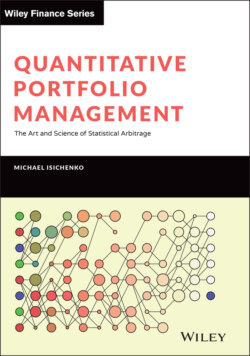Читать книгу Quantitative Portfolio Management - Michael Isichenko - Страница 7
Abstract
ОглавлениеThe book presents a systematic review of the quantitative equity trading process, aka statistical arbitrage, including market and other financial data, alpha generation, risk, trading costs, and portfolio construction. Financial forecasting involves statistical learning of future asset returns on features extracted from relevant current and past data, including price-volume, fundamental and analyst, holdings and flows, news, alternative, and other publicly available datasets. Both theoretical and algorithmic machine learning (ML) aspects of financial forecasting are reviewed with an emphasis on regularization methods, bias-variance and other tradeoffs, generalization error, the curse of dimensionality, and traps of overfitting. ML involves a wealth of parametric, nonparametric, deep, online, and latent structure algorithms, whose success is data-dependent according to the “No free lunch” theorem. Meta-learning methods include hyperparameter optimization, boosting, and other ensemble methods. An important context of financial ML is competition-based market efficiency imposing limits on the acceptable complexity and expected performance of predictive models. Some topics of active research such as “benign overfitting” in interpolating deep neural nets and other ML algorithms are also covered. Several approaches of combining multiple forecasts are discussed using secondary ML, dimensionality reduction, and other methods, while highlighting correlation-based limits on alpha diversification. Multi-factor risk models and trading costs are reviewed including both theoretical and empirical aspects relevant to portfolio construction. Effects of price impact on stock market macro elasticity are also discussed. A unified framework of multi-period portfolio optimization is presented with several special closed-form solutions with impact and slippage costs and approximations for efficient algorithmic approaches. Optimal portfolio capacity and leverage are discussed, including a critical review of the Kelly criterion. The book also presents a brief review of intraday algorithmic execution and high-frequency trading (HFT) and raises fundamental questions of more efficient market design to benefit the general investing public.
